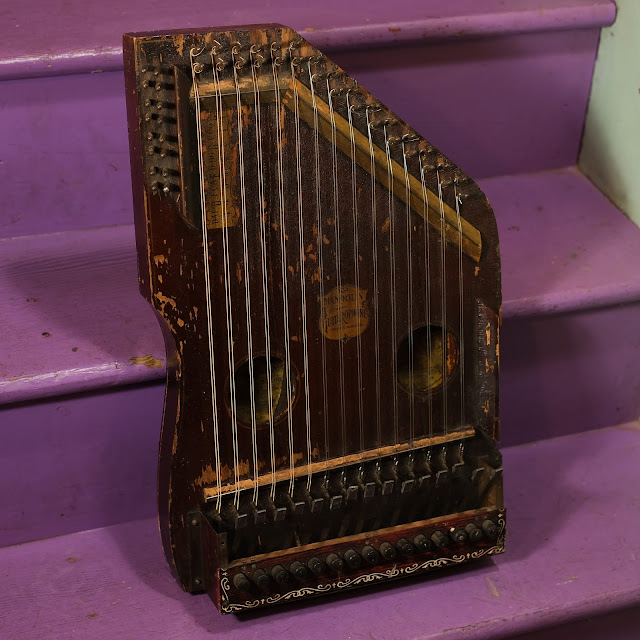1910s Oscar Schmidt "Mandolin Guitarophone" (Marxophone) Keyed Zither
While the Marxophone is somewhat well-known around recording studios, this iteration of the bizarre device is called a "Mandolin Guitarophone." Rather than pressing-down directly on the spring-steel-shaft hammers to generate sound, this guy uses button-accordion-like keys to do the job. They give it more of a piano-like or harpsichord-like attack that's exceedingly satisfying. When I finished adjusting this and began playing it, our whole household came into the workshop to give it a go because it's simply far too fun an instrument to not play.
A customer bought this and had it shipped here for me to do a once-over on it. It'd had some decent repairs in the past and it was playing OK as it was, but it'd been strung-up incorrectly which meant that there was no back-angle over the wire "saddles" that the strings ride over and a lot of the notes were thwibbbbbbing-out, so to speak. It was also -- curiously -- tuned to octaves on the lower-register strings.
So, I restrung the whole thing to suit its "standard" tuning -- CDEFGABCDEFGABC low to high -- with standard guitar wire in unison pairs so they'd be easy to replace if necessary. Compared to the piano-wire/autoharp strings these would traditionally have, these sound slightly silkier and springier and give a more "mandolin-like" sound, though they're a hair quieter. It's still loud, though, mind you.
The rest of the "work" was simply eliminating rattles on the metal housing for the buttons and massaging the spring-steel shafts of the hammers until they were striking the strings as accurately and as balanced as they could be. These pieces of steel are... not intended to be on any NASA missions... so they're not exact science.
But -- dang it! -- listen to that video clip. Is that not gorgeous? I think my favorite part is playing whole chords using the vibrato/chittering technique. That would be lovely on a record.
And -- dang it! -- doesn't a device like this make you think a modern equivalent could be amazing? Imagine one with a slightly longer scale, deeper and more responsive soundbox, and better-machined striking mechanism. Imagine it with guitar tuners so tuning is not as much of a pain in the butt as the friction autoharp pegs. Imagine it with either a magnetic or piezo pickup system installed. Ideas!
And that, folks, is what music -- for the player -- is all about... constant reinvention and lifelong learning. Plus -- fun. Fun, fun, fun, fun...








Comments
Here's a nice example: https://www.youtube.com/watch?v=E6QOr-oCTwU
Andy was also an expert zither player. You can find his zither videos on YouTube. Not sure if he ever did any demos of this instrument though...
Dave Goessling